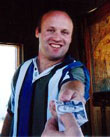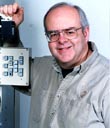|
|
This topic comprises 2 pages: 1 2
|
|
Author
|
Topic: Shutters & Parts
|
|
|
|
|
John Walsh
Film God

Posts: 2490
From: Connecticut, USA, Earth, Milky Way
Registered: Oct 1999
|
 posted 09-29-2000 10:08 AM
posted 09-29-2000 10:08 AM




A 3-bladed shutter is mostly used when transfering TV images to video. The fields/frames are different between TV and film, and a 3-bladed shutter compensates for this. They are also used insome review rooms to get a picture with less flicker.I would keep the changeover shutter, usually referred to as the "zipper" after a company that manufactures them. It looks nicer to not see the countdown, writing and other stuff on the film.I would also keep the safety shutter. It usually does not break, and helps prevent the film from burning if the projector slows down. For example, if the projector belt breaks, or the fuse on just the motor opens, the automation will not "know" and not shut off the lamp.
| IP: Logged
|
|
John Pytlak
Film God

Posts: 9987
From: Rochester, NY 14650-1922
Registered: Jan 2000
|
 posted 09-29-2000 10:32 AM
posted 09-29-2000 10:32 AM





I agree with John that it's a good idea to keep the centrifical "fire shutter", since it will protect the film from burning if the projector slows or stops. Many modern projectors leave these out of their designs, since they were only mandated for nitrate film. But saving any print from a burned frame is worthwhile.AFAIK, projectors intended for telecine (film-to-video) use a FIVE blade shutter, along with a special fast pulldown, to achieve the 3:2 pulldown frame rate conversion from 24 fps film to 30 fps video without flicker. 3-blade shutters are widely used in screening rooms, to almost completely eliminate any perception of shutter flicker (3 x 24 = 72 interruptions per second, so flicker is much less visible). A 3-blade shutter can also be used in theatre applications to minimize flicker, as long as you have enough light to overcome the lower shutter efficiency. Using a 3-blade shutter to minimize flicker, I've projected prints at light levels up to 60 footlamberts on a smaller screen, and they look stunning. The current screen luminance standard of 16 footlamberts specified by SMPTE 196M (with an allowed range of 12-22 fL for theatres) was primarily driven by the need to reduce flicker perception with a 2-blade shutter having only 48 interruptions per second. For a home theatre with a small screen, and excess light, using a 3-blade shutter would offer the advantage of almost no flicker, and the ability to increase the light level well above 16 footlamberts, to see that "brighter is better" usually produces stunning images. Of course, when showing silent films at 16 fps, a three-blade shutter must be used, since flicker with a two-blade shutter would be very annoying. ------------------
John P. Pytlak, Senior Technical Specialist
Worldwide Technical Services, Entertainment Imaging
Eastman Kodak Company
Research Labs, Building 69, Room 7419
Rochester, New York, 14650-1922 USA
Tel: 716-477-5325 Fax: 716-722-7243
E-Mail: john.pytlak@kodak.com
| IP: Logged
|
|
|
|
|
|
John Pytlak
Film God

Posts: 9987
From: Rochester, NY 14650-1922
Registered: Jan 2000
|
 posted 09-29-2000 11:31 AM
posted 09-29-2000 11:31 AM





A "drive-in shutter" may be one of two things. A conventional 4:1 "Geneva" intermittent using a maltese cross movement requires a nominal shutter blade of 90-degrees to block the light during the film pulldown. (See Tim Reed's excellent animated video of how an intermittent works in the "Videos" section of Film-Tech). Otherwise, light going through the film while it is moving will cause "travel ghost" on the screen. With the low light levels typical in a drive-in, a shutter blade under 90 degrees might be used to gain slightly more efficiency at the expense of a bit of travel ghost. Special high speed "drive-in" intermittents used an extra mechanical linkage to decrease the pulldown time. A 5:1 high speed intermittent could advance the frame in only about 72-degrees (360/5 = 72). So the shutter blades used with these intermittents could be as small as about 72 degrees, putting even more light on the screen. The disadvantage of the high speed intermittents was that the extra linkage made them noisier and more problematic. The higher film accelerations also put more stress on the film perforations, which was more of an issue on triacetate prints than today's tough polyester prints. ------------------
John P. Pytlak, Senior Technical Specialist
Worldwide Technical Services, Entertainment Imaging
Eastman Kodak Company
Research Labs, Building 69, Room 7419
Rochester, New York, 14650-1922 USA
Tel: 716-477-5325 Fax: 716-722-7243
E-Mail: john.pytlak@kodak.com
| IP: Logged
|
|
|
|
|
|
John Pytlak
Film God

Posts: 9987
From: Rochester, NY 14650-1922
Registered: Jan 2000
|
 posted 09-29-2000 12:57 PM
posted 09-29-2000 12:57 PM





AFAIK, "drive-in" intermittents are only available on the used equipment market. Don't know if Simplex was the only type, and whether having the extra linkage was the only design.Mark: When you saw the improved definition and steadiness, could it be that you were using it with 90-degree shutter blades? If the film was pulled into position within 72 degrees, it would have more time to stabilize in the gate before the shutter opened. ------------------
John P. Pytlak, Senior Technical Specialist
Worldwide Technical Services, Entertainment Imaging
Eastman Kodak Company
Research Labs, Building 69, Room 7419
Rochester, New York, 14650-1922 USA
Tel: 716-477-5325 Fax: 716-722-7243
E-Mail: john.pytlak@kodak.com
| IP: Logged
|
|
|
|
John Pytlak
Film God

Posts: 9987
From: Rochester, NY 14650-1922
Registered: Jan 2000
|
 posted 09-29-2000 02:16 PM
posted 09-29-2000 02:16 PM





Mark:Did the Century CS-55 movements get adapted for use in the Century JJ 35/70? Over on r.a.m.t, they are looking for evidence that 55 mm prints of "Carousel" and "The King and I" were actually used in theatres. Where were the projectors installed? Were they 6-perf or 8-perf pulldown? In any case, with a high speed movement, the stress on the perfs had to be pretty high, especially with triacetate prints. ------------------
John P. Pytlak, Senior Technical Specialist
Worldwide Technical Services, Entertainment Imaging
Eastman Kodak Company
Research Labs, Building 69, Room 7419
Rochester, New York, 14650-1922 USA
Tel: 716-477-5325 Fax: 716-722-7243
E-Mail: john.pytlak@kodak.com
| IP: Logged
|
|
|
|
John Pytlak
Film God

Posts: 9987
From: Rochester, NY 14650-1922
Registered: Jan 2000
|
 posted 09-29-2000 03:01 PM
posted 09-29-2000 03:01 PM





Rory:I'm not surprised at the quality you are getting with a 3-blade shutter. Certainly gets rid of flicker, and allows a high level of illumination. As you note, the lower efficiency of a 3-blade shutter needs a larger lamp for a given image size. What size and type of screen are you lighting with that 4500 watt lamp? What is the screen luminance? With a curved gain screen and decent optics, I would guess a screen up to about 20 x 48 feet would be possible, even with a 3-blade shutter. ------------------
John P. Pytlak, Senior Technical Specialist
Worldwide Technical Services, Entertainment Imaging
Eastman Kodak Company
Research Labs, Building 69, Room 7419
Rochester, New York, 14650-1922 USA
Tel: 716-477-5325 Fax: 716-722-7243
E-Mail: john.pytlak@kodak.com
| IP: Logged
|
|
|
|
|
|
All times are Central (GMT -6:00)
|
This topic comprises 2 pages: 1 2
|
Powered by Infopop Corporation
UBB.classicTM
6.3.1.2
The Film-Tech Forums are designed for various members related to the cinema industry to express their opinions, viewpoints and testimonials on various products, services and events based upon speculation, personal knowledge and factual information through use, therefore all views represented here allow no liability upon the publishers of this web site and the owners of said views assume no liability for any ill will resulting from these postings. The posts made here are for educational as well as entertainment purposes and as such anyone viewing this portion of the website must accept these views as statements of the author of that opinion
and agrees to release the authors from any and all liability.
|

 Home
Home
 Products
Products
 Store
Store
 Forum
Forum
 Warehouse
Warehouse
 Contact Us
Contact Us




 Printer-friendly view of this topic
Printer-friendly view of this topic















